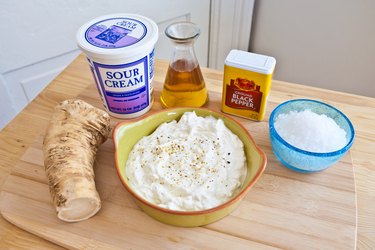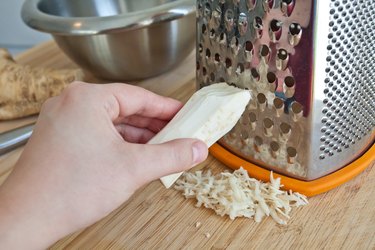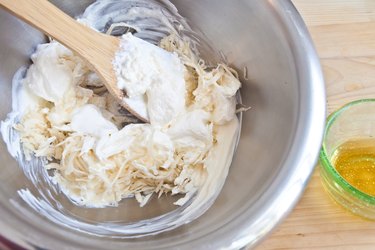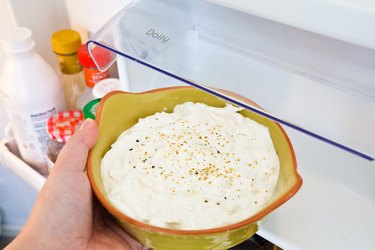Things You'll Need
Fresh horseradish root
Stiff vegetable brush
Paring knife
Glass or stainless steel bowl
Disposable kitchen gloves (optional)
Grater
Sour cream or creme fraiche
White vinegar
Salt and pepper

A nicely roasted piece of beef is rich and flavorful in its own right, but it's all the better with a few well-chosen accompaniments. Chief among the traditional choices is horseradish sauce, its tart and fiery pungency acting as a foil to the richness of the meat, gravy and side dishes. Commercial horseradish sauces are often bland, but a sauce fresh-made at home -- from prepared or fresh horseradish -- requires little effort, and packs a greater punch.
Step 1

Scrub the root with a stiff brush to remove any soil from its many crevices, and then peel it with a sharp paring knife.
Video of the Day
Step 2

Place a stainless steel or glass bowl on your work surface, and pull on a pair of disposable kitchen gloves. This is optional, but gloves stop your hands from smelling of horseradish -- or accidentally transferring the juice to your eyes or nose -- the rest of the day. Open any nearby windows, because the freshly grated root is very pungent and will quickly become overpowering in a closed space.
Step 3

Shred the horseradish root into the bowl, working as quickly as possible to minimize the quantity of pungent vapor in the air. For every 1/4 cup of horseradish, add a cup of sour cream or creme fraiche and roughly a teaspoon of white vinegar.
Step 4

Stir the mixture; season it lightly with salt and pepper, and taste it. It should have a sharp but balanced flavor, with a bright tang from the vinegar and sinus-clearing heat from the horseradish. Add cream, vinegar or salt as necessary until you're happy with the flavor.
Step 5

Refrigerate the sauce for at least 20 to 30 minutes so the flavors can mellow and mature, before serving. Use the finished sauce within two to four days for the best flavor.
Tip
If your kitchen is poorly ventilated, consider shredding the horseradish outdoors at a picnic table or folding table so you don't fill your home with pungent horseradish vapors, which can be distinctly irritating. Some cooks opt to wear a pair of swimming goggles as well, to protect their eyes against the spray of juice. Alternatively, use the shredding disc of your food processor.
If you enjoy horseradish but would prefer not to cope with the fresh root, purchase a jar of prepared horseradish to use instead of the fresh. You'll need to use slightly more of the prepared root, and slightly less vinegar and salt since those are already included.
White wine vinegar or cider vinegar can be substituted, but the sharper bite of plain white vinegar is more appropriate for this assertive condiment.
If you shred more horseradish than you need for your sauce, make a sandwich spread by stirring horseradish together with mayonnaise, or a mixture of mayonnaise and deli mustard.
Video of the Day